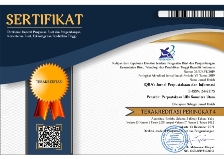User Satisfaction To The Quality Of Repository Services At An Academic Library: Applying Libqual+
Abstract
Universitas Islam Negeri (UIN) Prof Saifuddin Zuhri's Library has a collection of theses, dissertations, and research reports from print to digital, which can be accessed through the institution's repository. Thesis and repository services are needed by final-year students who are completing thesis assignments. This paper assesses the quality of repository services using the LibQual+TM standard as set by the Association of Research Libraries (see http://libqual.org). The research method is quantitative, with the UIN student population from semester 8 and semester. The number of samples was 93 taken randomly. The results showed that the quality of repository services got an average value of 3.12 on a scale of 4.0, which indicates The lowest value of 2.76 shows that although users are satisfied as a whole, they still feel that the facilities in the institutional repository are incomplete with several proposals for improving the benefits of institutional repositories. Student suggestions for improvment include: an adequate internet network, an easy search menu, instruction of the functions of the repository and more intensive promotion of the repository to heighten access to research information. This study contributes heightened understanding for the value of digitized repository services in academic libraries as a vital information literacy tool for college students.
Keywords
Full Text:
PDFReferences
Aabø, S., & Audunson, R. (2012). Use of library space and the library as place. Library & Information Science Research, 34(2), 138–149. https://doi.org/10.1016/j.lisr.2011.06.002
ACRL. (2020). LibGuides: Scholarly Communication Toolkit: Scholarly Communication Overview. //acrl.libguides.com/scholcomm/toolkit/home
admin. (1999, November 30). Competencies for Librarians Serving Children in Libraries [Text]. Association for Library Service to Children (ALSC). https://www.ala.org/alsc/edcareeers/alsccorecomps
admin. (2006, July 26). Restricted Access to Library Materials: An Interpretation of the Library Bill of Rights [Text]. Advocacy, Legislation & Issues. https://www.ala.org/advocacy/intfreedom/librarybill/interpretations/restrictedaccess
Antasari, I. W., & Chakim, S. (2019). Analysis Of User Satisfaction On Self-Loan Services in Islamic State Institute (IAIN) Purwokerto Library. EARR (Educational Administration Research and Review), 3(2), 66–75. https://doi.org/10.17509/earr.v3i2.22368
Antasari, I. W., Setiansah, M., Istiyanto, S. B., Sugito, T., & Novianti, W. (2021). The Impact of Repository Service Quality Toward Final Year Students. https://digitalcommons.unl.edu/libphilprac/5813/
Ayoung, D. A., Baada, F. N.-A., & Baayel, P. (2021). Access to library services and facilities by persons with disability: Insights from academic libraries in Ghana. Journal of Librarianship and Information Science, 53(1), 167–180. https://doi.org/10.1177/0961000620917723
Buckland, M. K. (2014). Library services in theory and context. Elsevier.
Casserly, M. F. (2004). Collection management as risk management. Library Collections, Acquisitions, & Technical Services, 28(1), 79–92. https://doi.org/10.1080/14649055.2004.10765976
Cha, S. H., & Kim, T. W. (2015). What matters for students’ use of physical library space? The Journal of Academic Librarianship, 41(3), 274–279.
Connor, E. (Ed.). (2009). An Introduction To Staff Development In Academic Libraries (0 ed.). Routledge. https://doi.org/10.4324/9780203883006
Costello, L. (2020). Survey of canadian academic librarians outlines integration of traditional and emerging services. Evidence Based Library and Information Practice, 15(3), 184–186. Scopus. https://doi.org/10.18438/eblip29789
Gstalder, S. H. (2017). Understanding Library Space Planning [Ed.D.]. https://www.proquest.com/docview/1954088754/abstract/41785338463547EBPQ/1
Habiburrahman, & Nabila, J. (2022). Perpustakaan Digital: Pengembangan Repository Sebagai Sarana Preservasi Digital. Pascal Books.
Hasugian, J., & Lubis, D. (2021). Library service quality and student trust: A case study of the university of sumatera utara library, Indonesia. DESIDOC Journal of Library and Information Technology, 41(5), 345–351. Scopus. https://doi.org/10.14429/djlit.41.5.16406
Ibrahim, I. S., & Iriantara, Y. (2017). Komunikasi yang Mengubah Dunia. Simbiosa Rekatama Media.
Lee, J., Burnett, G., Vandegrift, M., Baeg, J. H., & Morris, R. (2015). Availability and accessibility in an open access institutional repository: A case study. Information Research: An International Electronic Journal, 20(1), n1.
Mayende, C., Awuor, F. M., & Namande, B. (2021). Customer-Centric Service Provision in Academic Libraries in Universities: Systematic Literature Review. Technology and Investment, 12(04), 217–239. https://doi.org/10.4236/ti.2021.124013
Mujahidah, A. S., Rusydiana, A. S., Hasib, F. F., & Nasrulloh, A. A. (2021). The Determinants of Satisfaction and Loyalty to Digital Libraries: Islamic Economics Student Perspective in Indonesia. Library Philosophy and Practice (e-Journal), Fall(12–9), 17.
Nasution. (2014). Metode Research: Penelitian Ilmiah. Bumi Aksara.
Nitecki, D. A. (2011). Space Assessment as a Venue for Defining the Academic Library. The Library Quarterly, 81(1), 27–59. https://doi.org/10.1086/657446
Nurmalina, dkk. (2022). Kreatif atau Mati: Perpustakaan Perguruan Tinggi Islam Merespon Pandemi (L. Zain, W. Suwarno, & U. Andayani, Eds.). AZYAN MITRA MEDIA. https://doi.org/10/1/e-Book%20-%20KREATIF%20ATAU%20MATI.pdf
Pendit, P. L. (2008). Perpustakaan Digital dari A sampai Z. Cita Karyakarsa Mandiri.
Pramudyo, G. N., Putri, Z. S., Prayogi, I. A., Sari, A. M., Widianah, S., & Trisnawati, Y. (2018). Penerapan EPrint sebagai Repositori Institusi pada Perpustakaan Universitas Muhammadiyah Malang. Khizanah al-Hikmah : Jurnal Ilmu Perpustakaan, Informasi, dan Kearsipan, 6(1), Article 1. https://doi.org/10.24252/kah.v6i1a2
Rahayuningsih, F. (2015). Mengukur Kepuasan Pemustaka: Menggunakan Metode Libqual+TM. Graha Ilmu.
Repository UIN Prof KH Saifuddin Zuhri. (2020). repository.iainpurwokerto.ac.id
Salauddin, N. (2015). Library User Visit of under Graduate Students at an Engineering College, Central Library, Affiliated by APJ Abdul Kalam University, Lucknow A case Study. International Research: Journal of Library and Information Science, 5(4).
Stewart, M. C., Atilano, M., & Arnold, C. L. (2017). Improving customer relations with social listening: A case study of an American academic library. International Journal of Customer Relationship Marketing and Management (IJCRMM), 8(1), 49–63.
Umut Zan, B., Çolaklar, H., Altay, A., & Taşkın, N. (2020). A Study on Digital Literacy Skills of Faculty of Letters Students: Use of University Library. International Journal of Emerging Technologies in Learning, 16(1), 152–171. Scopus. https://doi.org/10.3991/IJET.V16I01.16567
Waugh, L., Hamner, J., Klein, J., & Brannon, S. (2015). Evaluating the University of North Texas’ Digital Collections and Institutional Repository: An Exploratory Assessment of Stakeholder Perceptions and Use. The Journal of Academic Librarianship, 41(6), 744–750. https://doi.org/10.1016/j.acalib.2015.08.007
Wexelbaum, R. (2016). The Library as Safe Space. In S. S. Hines & K. M. Crowe (Eds.), Advances in Library Administration and Organization (Vol. 36, pp. 37–78). Emerald Group Publishing Limited. https://doi.org/10.1108/S0732-067120160000036002
Wickens, C. M., & Miller, T. (2020). Gender, Digital Literacies, and Higher Education: Examinations of Equity. In N. S. Niemi & M. B. Weaver‐Hightower (Eds.), The Wiley Handbook of Gender Equity in Higher Education (1st ed., pp. 53–67). Wiley. https://doi.org/10.1002/9781119257639.ch3
Xi, Q., Zhao, H., Hu, Y., Tong, Y., & Bao, P. (2018). Case studies and comparison between two models for assessing library service quality. The Electronic Library, 36(6), 1099–1113. https://doi.org/10.1108/EL-11-2016-0246
Yuniasih, Tupan, Setiorini, R. A., & Putri, R. A. (2018). Model Pemanfaatan Konten Repository. In Model Pemanfaatan Konten Repository (pp. 5–15). Pusat Dokumentasi dan Informasi Ilmiah, LIPI.
DOI: http://dx.doi.org/10.30829/iqra.v18i2.21611
Refbacks
- There are currently no refbacks.
Copyright (c) 2024 Indah Wijaya Antasari

This work is licensed under a Creative Commons Attribution-ShareAlike 4.0 International License.
IQRA': JURNAL PERPUSTAKAAN DAN INFORMASI
Perpustakaan Universitas Islam Negeri Sumatera Utara
Jalan Willem Iskandar Pasar V Medan Estate
20371
Medan - Sumatera Utara






